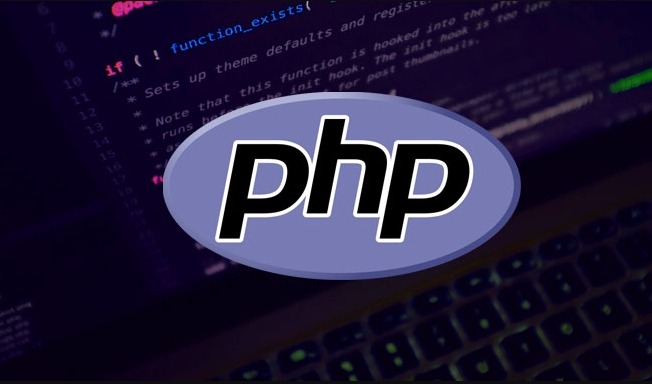Regular expressions for verifying email address can be implemented through regex in PHP. The common writing method is: ^[a-zA-Z0-9.\_% -] @[a-zA-Z0-9.-] \.[a-zA-Z]{2,}$. 1. The user name part allows letters, numbers and partial symbols, such as dots, underscores, percent signs, etc., to represent at least one character; 2. The domain name part consists of letters, numbers, dots and minus signs, and the top-level domain name requires more than two letters; 3. This rule is suitable for most actual scenarios, but does not fully comply with the RFC standard; 4. It is recommended to use the PHP built-in function filter_var() for verification first; 5. When using the rule, you can consider adding modifiers i and u to improve compatibility.

Regular expressions for verifying email addresses are a common requirement in PHP. Although PHP has a built-in function filter_var() that can be used directly to verify mailboxes, sometimes you may need more flexible control, and you need to use regular expressions (regex).

The following regular expression is a relatively general way to write it in terms of practicality and compatibility:

$email = "example@test.com";
if (preg_match("/^[a-zA-Z0-9._% -] @[a-zA-Z0-9.-] \.[a-zA-Z]{2,}$/", $email)) {
echo "valid mailbox";
} else {
echo "Invalid mailbox";
}The structure of this regular expression can be broken down into several parts to understand.
Email username part: [a-zA-Z0-9._% -]
The @ of the mailbox is preceded by the username part, which usually allows the following characters:

- Letters az and AZ
- Numbers 0-9
- dot number
., underline__percent sign%, plus sign-
Note that this is used here Indicates that there is at least one character.
Common legal user names such as:
- john.doe
- user 123
- test%email
So this part of regular writing: [a-zA-Z0-9._% -]
Email domain name part: [a-zA-Z0-9.-] \.[a-zA-Z]{2,}
@The following part is domain names and top-level domain names, such as gmail.com or mail.co.uk
- The domain name body consists of letters, numbers, dots and minus signs:
[a-zA-Z0-9.-] - Then there is a dot number
\.(Please escape) - Finally, there are top-level domains, usually two or more letters:
[a-zA-Z]{2,}
For example:
- example.com ?
- sub.mail.co.uk ?
- exa_mple.com ? (Domain name does not allow underscore)
Some things to note
- This regularity is loose and will not cover all legal mailbox formats defined by RFC standards, but can meet most practical usage scenarios.
- If you pursue extreme standard compatibility, the rules will become very complex, even hundreds of characters, but they are not recommended in daily development.
- Users are not advised to build their own wheels unless there are special needs. PHP's
filter_var($email, FILTER_VALIDATE_EMAIL)is a safer choice.
Tips: Common modifiers for PHP regular
If you have problems using regulars, check if the modifier is missing:
-
i: case insensitive (optional) -
u: Process UTF-8 encoding (if international mailbox is supported, you can add it)
For example:
"/^[a-zA-Z0-9._% -] @[a-zA-Z0-9.-] \.[a-zA-Z]{2,}$/iu"Basically that's it. If you use this rule well, you can complete the basic verification of the email format in most cases.
The above is the detailed content of php regex for email validation. For more information, please follow other related articles on the PHP Chinese website!

Hot AI Tools

Undress AI Tool
Undress images for free

Undresser.AI Undress
AI-powered app for creating realistic nude photos

AI Clothes Remover
Online AI tool for removing clothes from photos.

Clothoff.io
AI clothes remover

Video Face Swap
Swap faces in any video effortlessly with our completely free AI face swap tool!

Hot Article

Hot Tools

Notepad++7.3.1
Easy-to-use and free code editor

SublimeText3 Chinese version
Chinese version, very easy to use

Zend Studio 13.0.1
Powerful PHP integrated development environment

Dreamweaver CS6
Visual web development tools

SublimeText3 Mac version
God-level code editing software (SublimeText3)
 PHP Variable Scope Explained
Jul 17, 2025 am 04:16 AM
PHP Variable Scope Explained
Jul 17, 2025 am 04:16 AM
Common problems and solutions for PHP variable scope include: 1. The global variable cannot be accessed within the function, and it needs to be passed in using the global keyword or parameter; 2. The static variable is declared with static, and it is only initialized once and the value is maintained between multiple calls; 3. Hyperglobal variables such as $_GET and $_POST can be used directly in any scope, but you need to pay attention to safe filtering; 4. Anonymous functions need to introduce parent scope variables through the use keyword, and when modifying external variables, you need to pass a reference. Mastering these rules can help avoid errors and improve code stability.
 How to handle File Uploads securely in PHP?
Jul 08, 2025 am 02:37 AM
How to handle File Uploads securely in PHP?
Jul 08, 2025 am 02:37 AM
To safely handle PHP file uploads, you need to verify the source and type, control the file name and path, set server restrictions, and process media files twice. 1. Verify the upload source to prevent CSRF through token and detect the real MIME type through finfo_file using whitelist control; 2. Rename the file to a random string and determine the extension to store it in a non-Web directory according to the detection type; 3. PHP configuration limits the upload size and temporary directory Nginx/Apache prohibits access to the upload directory; 4. The GD library resaves the pictures to clear potential malicious data.
 Commenting Out Code in PHP
Jul 18, 2025 am 04:57 AM
Commenting Out Code in PHP
Jul 18, 2025 am 04:57 AM
There are three common methods for PHP comment code: 1. Use // or # to block one line of code, and it is recommended to use //; 2. Use /.../ to wrap code blocks with multiple lines, which cannot be nested but can be crossed; 3. Combination skills comments such as using /if(){}/ to control logic blocks, or to improve efficiency with editor shortcut keys, you should pay attention to closing symbols and avoid nesting when using them.
 How Do Generators Work in PHP?
Jul 11, 2025 am 03:12 AM
How Do Generators Work in PHP?
Jul 11, 2025 am 03:12 AM
AgeneratorinPHPisamemory-efficientwaytoiterateoverlargedatasetsbyyieldingvaluesoneatatimeinsteadofreturningthemallatonce.1.Generatorsusetheyieldkeywordtoproducevaluesondemand,reducingmemoryusage.2.Theyareusefulforhandlingbigloops,readinglargefiles,or
 Tips for Writing PHP Comments
Jul 18, 2025 am 04:51 AM
Tips for Writing PHP Comments
Jul 18, 2025 am 04:51 AM
The key to writing PHP comments is to clarify the purpose and specifications. Comments should explain "why" rather than "what was done", avoiding redundancy or too simplicity. 1. Use a unified format, such as docblock (/*/) for class and method descriptions to improve readability and tool compatibility; 2. Emphasize the reasons behind the logic, such as why JS jumps need to be output manually; 3. Add an overview description before complex code, describe the process in steps, and help understand the overall idea; 4. Use TODO and FIXME rationally to mark to-do items and problems to facilitate subsequent tracking and collaboration. Good annotations can reduce communication costs and improve code maintenance efficiency.
 Quick PHP Installation Tutorial
Jul 18, 2025 am 04:52 AM
Quick PHP Installation Tutorial
Jul 18, 2025 am 04:52 AM
ToinstallPHPquickly,useXAMPPonWindowsorHomebrewonmacOS.1.OnWindows,downloadandinstallXAMPP,selectcomponents,startApache,andplacefilesinhtdocs.2.Alternatively,manuallyinstallPHPfromphp.netandsetupaserverlikeApache.3.OnmacOS,installHomebrew,thenrun'bre
 How to access a character in a string by index in PHP
Jul 12, 2025 am 03:15 AM
How to access a character in a string by index in PHP
Jul 12, 2025 am 03:15 AM
In PHP, you can use square brackets or curly braces to obtain string specific index characters, but square brackets are recommended; the index starts from 0, and the access outside the range returns a null value and cannot be assigned a value; mb_substr is required to handle multi-byte characters. For example: $str="hello";echo$str[0]; output h; and Chinese characters such as mb_substr($str,1,1) need to obtain the correct result; in actual applications, the length of the string should be checked before looping, dynamic strings need to be verified for validity, and multilingual projects recommend using multi-byte security functions uniformly.
 Learning PHP: A Beginner's Guide
Jul 18, 2025 am 04:54 AM
Learning PHP: A Beginner's Guide
Jul 18, 2025 am 04:54 AM
TolearnPHPeffectively,startbysettingupalocalserverenvironmentusingtoolslikeXAMPPandacodeeditorlikeVSCode.1)InstallXAMPPforApache,MySQL,andPHP.2)Useacodeeditorforsyntaxsupport.3)TestyoursetupwithasimplePHPfile.Next,learnPHPbasicsincludingvariables,ech






